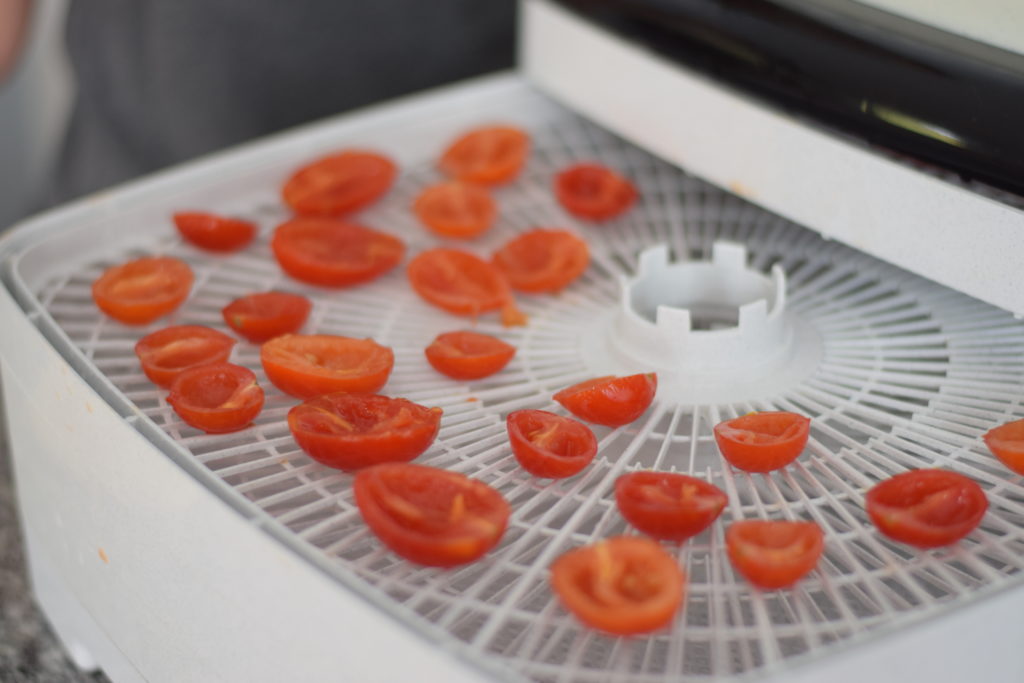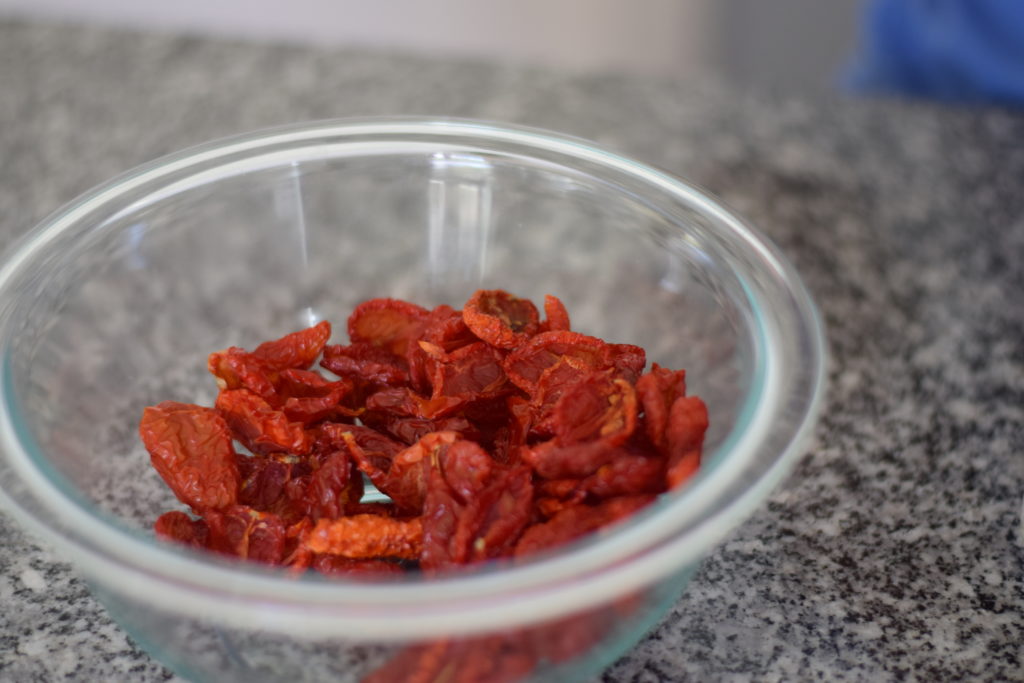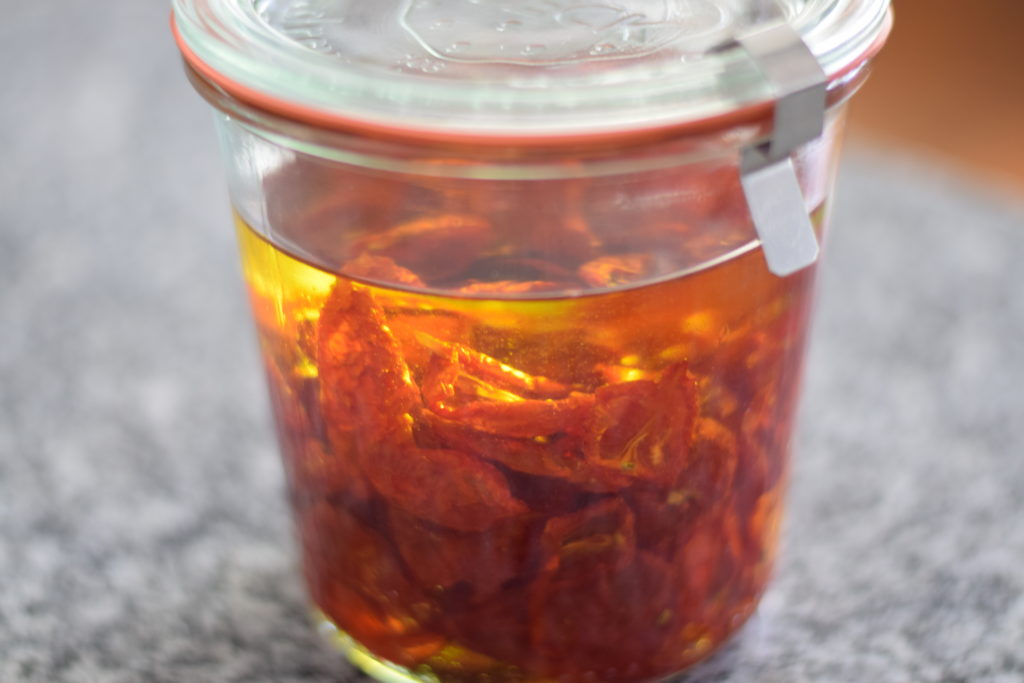We’ve talked about a number of ways to preserve foods when in season so we can enjoy them for months to come — canning, freezing, fermenting. Today we’ll talk about drying or dehydrating. You can dehydrate many foods for longer shelf-stable storage, even things you might not think of. Not only fruits and vegetables but also meat (think jerky), dairy or eggs. And there are a variety of ways to dehydrate foods using the sun, the air, the oven or a dehydrator. Today we’re making dried tomatoes stored in oil using our dehydrator.

Methods for dehydrating
- Air drying requires no electricity, is more gentle and is simple. Stringing peppers, laying foods out on a tray or hanging bundled herbs are some forms of air drying. The disadvantages of air drying are that it will take a bit longer than other methods, possibly also allowing spoilage, and without a covering, the food can collect dust, hair, and grease. This is helped by covering a tray with a towel or putting items without too much moisture into a paper bag, giving plenty of space for air.
- An oven will dehydrate much faster than some other methods, though it will require more of your attention and risks overheating the foods, causing burning or loss of nutrition.
- A dehydrator allows more flexibility with the temperature to reduce the risk of burning, is a bit faster than air drying, providing some protection against dust and spoilage.
Why Dehydrate?
To dehydrate, all we’re doing is removing the water from the tomatoes (or other food). This helps prevent spoilage organisms, such as mold, making it unsafe to eat. You can dehydrate without electricity. But even if you use electricity to dry your foods, you can then store them long-term without electricity. If done at low temperatures, the nutrition as well as the flavor can be retained. You can use dehydrated foods in cooking, just like frozen, with the possible exception of requiring a little extra moisture added to the recipe. Some, like fruit leather, jerky or our dried tomatoes stored in oil are great just as they are.

Choosing your tomatoes
You can dehydrate any tomatoes you have available. Though, a good choice are paste-type tomatoes. Considered so because they are “meatier” and have less water in them and will cook down into a sauce more quickly than a slicing tomato. It means they will dehydrate faster as well. We grow a variety called Principe Borghese, which has the meatiness of a paste tomato but is about the size of a cherry tomato and often used for sun-dried tomatoes. As always, choose only healthy vegetables, nothing bruised or moldy.
How to Make Dried Tomatoes Stored in Oil
- Because we want to be sure to eliminate the moisture, it’s a good idea to cut the tomatoes in half and get rid of the seeds and the juicy part around the seeds, no matter the size of the tomatoes you are dehydrating.
- Set tomatoes on the dehydrator tray cut side up, leaving plenty of room for air to flow around them.
- Fill trays, set the dehydrator to 115* or less and turn it on.
- Check your tomatoes every few hours as they will finish at different rates, depending on their size and placement.
- Rotate your trays every so often top to bottom and turn them front to back to allow more even drying.
- Tomatoes are ready when they are still flexible, but no longer have moisture coming out when you squeeze them. Carefully check each piece. One part of a tomato might be dry, but another part might still be wet.
- Once dry, dip each tomato piece into raw apple cider vinegar, and shake excess off. This gives additional assurance against mold and botulism since we will store them in oil. This step isn’t necessary if you will store your dried tomatoes without the oil.
- Place the tomato pieces into a very clean, pretty glass jar. Okay, pretty isn’t necessary, the dried tomatoes in oil will make the jar look pretty, but I do recommend glass because it is easily sanitized.
- Pour in a nice olive oil, making sure to cover the tomatoes. If your jar isn’t full, you can keep adding to it.
- These dried tomatoes stored in oil can be used for months to come in recipes very much like sun-dried tomatoes.

Tips
- If you place your dried food into a sealed container and later find small moisture droplets inside the container, your food isn’t fully dehydrated. Place it back into the dehydrator to finish it off before mold has a chance to grow.
- You can use other vinegars, though I don’t recommend white vinegar.
- If you have any tomatoes that get too crispy, you can powder them to use in other recipes.
Shop the Supplies
Weck jars (We used this size for the tomatoes, but there are a variety of sizes available.)
Watch Dried Tomatoes Stored in Oil

[…] Here is something else you can do to preserve tomatoes […]